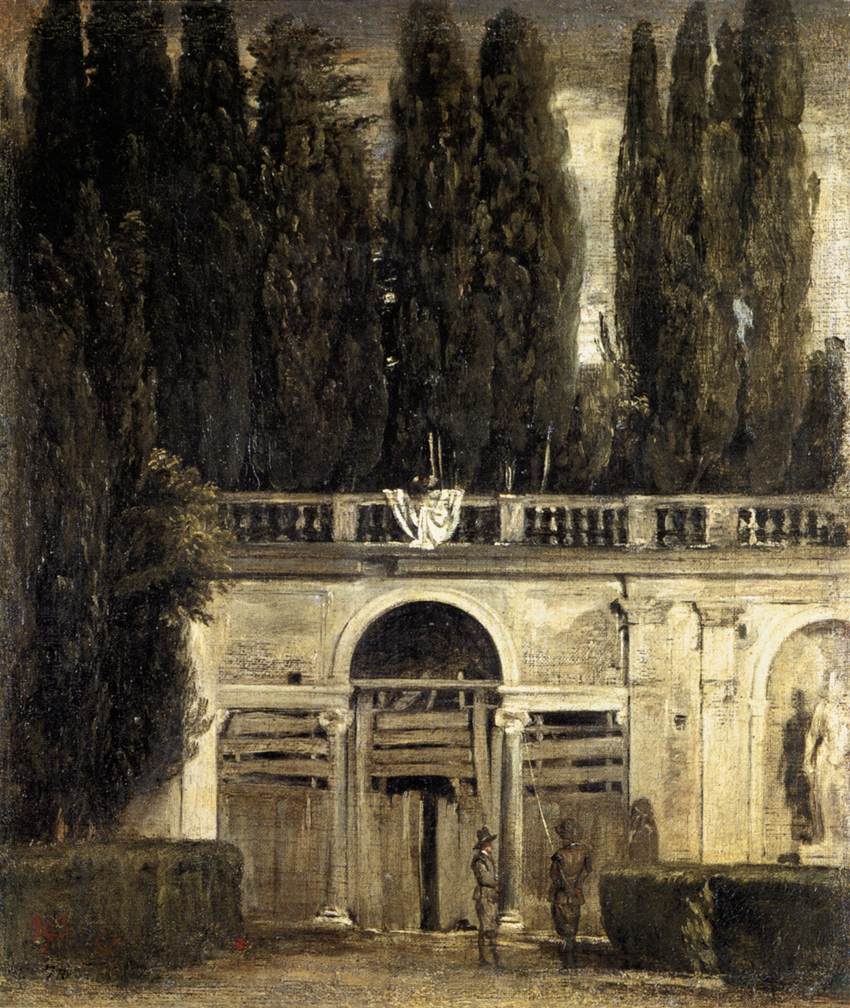Jacques-Louis David, View of the Gardens of the Palais du Luxembourg, 1794
'After walking through a play area, as usual not very pretty – poorly designed swings and toboggans, painted in glaring colours, since it is an established fact that children have no taste – I enter a piece of woodland that seems almost wild, as the gardeners have taken care to let it grow with the least constraint possible. Then, between the edge of this forest and the side of the square, marked by the walls of the Mobilier National, in the centre of the open space we find a 'creation' – in the sense that Encelade's copse at Versailles is a creation. There is a topiary quincunx of box bushes, with roses in the middle: four open semi-cylindrical arbours frame a small obelisk of raw stone. The roses climb over the arbours and embrace the obelisk. To give an idea of the charm of the place, you have to recall one of those painters who were not landscape artists but painted almost by chance a single landscape – I have in mind the Villa Medici Gardens by Velázquez, or David‘s view of the Luxembourg, painted from the cell where he awaited the guillotine after Thermidor.'
- Eric Hazan, describing the Square René-Le Gall in A Walk Through Paris, translated by David Fernbach, 2018
Diego Velázquez, View of the Garden of the Villa Medici, c. 1630
Reading this passage I thought it was an interesting way of describing the charm of an urban park, encountered as unexpectedly as these modest landscape views among the works of artists known for their figure painting. I wrote here last year about the Velázquez, but what of David's painting? There was actually a good article devoted to it in The Independent a few years ago, by Michael Glover. In the course of it h, discusses details like that group of figures engaged in some sort of activity.
'Are these people raking the earth itself? Are they mark-making? Are they engaged in an inscrutable game of some kind? What we do know for certain is that after the Revolution, parts of the Luxembourg Gardens were handed over to be tilled by the common people – in the new spirit of egalitarianism, no doubt. There is not much to be tilled here though, not at this time of year, not much evidence at all of Keats's season of mellow fruitfulness.'Why was David confined to this cell? I have written a post here before about the artificial landscape he designed for the first Celebration of the Supreme Being in June 1794. This marked the zenith of Robespierre's power - already people were turning against him and within a month he had been guillotined. David, apparently ill, managed to avoid the same fate but was eventually arrested and spent August to December 1794 in prison. Michael Glover reads the politics of revolution into the landscape David painted there.
'Two factors seem to be at odds with each other in this painting: order and disorder. That fence looks makeshift in the extreme – shockingly makeshift for such an august location. And yet the layout of the gardens themselves, that perfect alignment of trees, for example, somewhat reminds us of how the Luxembourg Gardens are these days, a project that depends for its grandeur and its power to impress upon the taming and ordering of nature in the interests of human reason. And so it is here. But the tops of the trees tell quite a rather story. In these gardens, we are used to the sight of severely pollarded trees. Nature is to be tamed and regulated. Here things have got out of hand. The unruly crowns of the trees are rejoicing in their untamed spirit.'He concludes by imagining David, in his high prison cell looking down on this view. 'Meditating upon partially untamed nature in this way may have helped his spirit to breathe.'


No comments:
Post a Comment